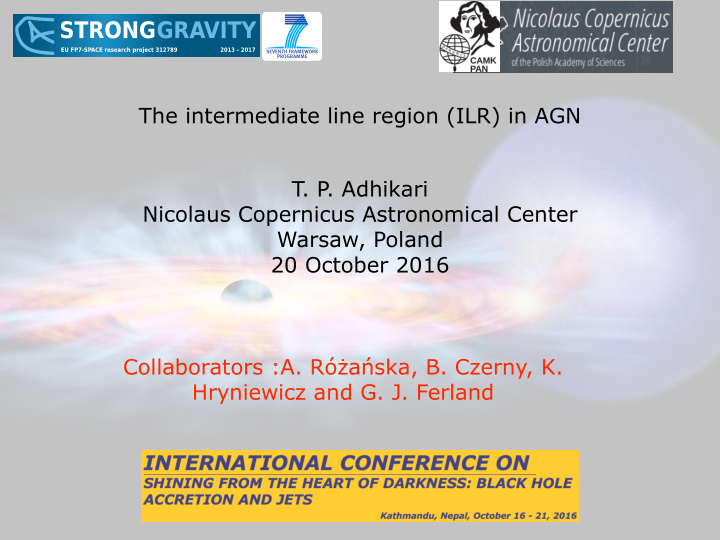



The intermediate line region (ILR) in AGN T. P. Adhikari Nicolaus Copernicus Astronomical Center Warsaw, Poland 20 October 2016 Collaborators :A. Ró ż a ń ska, B. Czerny, K. Hryniewicz and G. J. Ferland
Credit:Pierre Auger Observatory
Emission lines in the spectra of AGN narrow lines: FWHM~500 km /s broad lines: FWHM>2000 km /s Intermediate lines: FWHM ~ 700-1200 km /s ? Mehdipour + 2015
"Line emission vs radius" in AGN Netzer & Laor 1993 assumptions • constant density clouds • n H ∝ R − 3/2 , N H ∝ R − 1 • n H , N H at 0.1 pc = 10 9.4 cm -3 & 10 23.4 cm -2 • Solar composition <=0.1 Netzer & Laor 1993 pc • ISM composition with dust grains >0.1 pc
Recent observations (Puchnarewicz & Jones 1996, Crenshaw & Kraemer 2007, Hu+ 2008a,b, Crenshaw+ 2009, Zhu+ 2009, Li+ 2015) of some AGN shows intermediate line emission STIS echelle observation of NGC 5548 Intermediate lines: FWHM ~700-1200 km /s Crenshaw+ 2009 continuum + BLR (lower dotted–dashed green), continuum + BLR+ NLR (upper dotted–dashed green), continuum + BLR + ILR (dashed red) and continuum + BLR + ILR + NLR (upper dashed blue)
Photoionisation modelling of the emitting gas • Gas density n H • Broad band SED incident SED • Metallicity Z • Column Density N H • Ionisation parameter U • Solving the radiative transfer, ionisation equilibrium and thermal balance emission lines • Main Codes: CLOUDY, TITAN, XSTAR,.. Cloudy 13.03 (Ferland + 2013)
Is the presence of ILR in some AGN connected with the shape of SED? Adhikari + 2016, ApJ in press, arXiv:1606.00284
The answer is no! Adhikari + 2016, ApJ in press
Our model assumptions 3 9 9 1 r o a • constant density clouds L & r e • n H , N H at 0.1 pc = 10 9.4 z t e • n H ∝ R − 3/2 , N H ∝ R − 1 cm -3 & 10 23.4 cm -2 N • N H at 0.1 pc = 10 23.4 cm -2 • Solar composition <=0.1 pc • ISM composition with • n H at 0.1 pc = 10 11.5 cm -3 dust grains >=0.1 pc High local densities (~ 10 11 -10 12 cm -3 ) of emitting and absorbing clouds in AGN have been inferred for several sources (Leighly 2004, Bruh- weiler & Verner 2008, , Rozanska+ 2014, Hryniewicz + 2014, Modzelewska+ 2014, Sredzinska + 2016)
Dense clouds can be potentially formed from an accretion disk atmosphere Adhikari + 2016, ApJ in press
Adhikari + 2016, ApJ in press
The radial distances at which the various line luminosities peak are consistent with the results inferred from RM studies Adhikari + 2016, ApJ in press
High density clouds have lower H + column gas opacity always dominates for higher densities and it does not matter if the gas is dusty or not Adhikari + 2016, ApJ in press
Two important predictions of our model • Existence of ILR at distances 0.1-1 pc predicts the RM lag of ILR to be 100-1000 light-days • In our case, the effect of dust disappears if U is less than 0.01 (threshold value). So, in LINERS where the emission lines are produced by the photoionisation of the gas at U ≤ 10 − 3 (Ferland & Netzer (1983)), our result clearly predicts the presence of ILR in LINERS. The presence of ILR in 33 LINERS is also shown by Balmaverde + 2016 More to be explored !
Summary • The presence or absence of ILR is not determined by the spectral shape of the incident continuum. • With high density at sublimation radius i.e., 10 11.5 cm - 3, we obtained a continuous "line emission vs radius" showing the existence of ILR. So the density of the gas should be high enough for the intermediate line emission • The dense cloud can be potentially formed from an accretion disk atmosphere which is dense enough below the sublimation radius in the accretion disk • Such ILR is predicted to be located at radial distances r ∼ 0.1 − 1 pc, and the expected by our model the reverberation mapping lag would be of the order of 100-1000 light-days
Recommend
More recommend